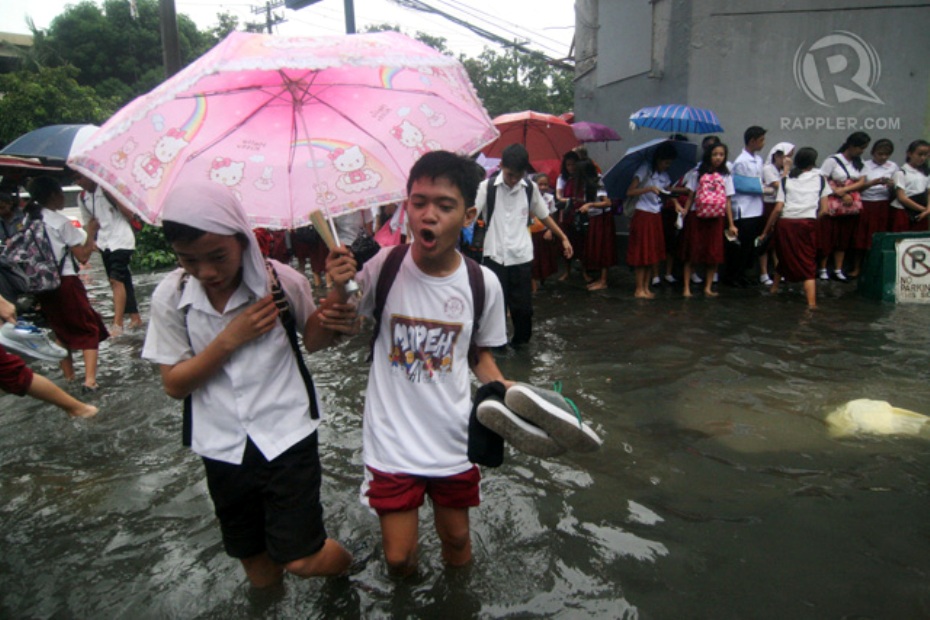AS FLOODS and torrential rains continue to inundate and paralyze the capital, the government has self-imposed a deadline—December 2013—to rectify the situation.
This deadline was announced by Department of Public Works and Highways (DPWH) Secretary Rogelio Singson and Metropolitan Manila Development Authority (MMDA) Chair Francis Tolentino last June 19 in an attempt to appease growing concerns and complaints triggered by the monsoon downpours.
Singson targeted December as the due date for the completion of around 70 of the 90 projects that should help mitigate the effects of flooding. These projects focus on drainage improvement, road elevation and the clearing of waterways of both informal settlements and waste.
These projects are in line with the government’s P352 billion flood control master plan, the target deadline of which is 2035.
A spot of bother
The recent rain has been troubling both commuters and drivers alike.
Junior management major Michelle Tan shared that she had difficulty getting back home while commuting. “I was stranded inside the Recto station for two hours,” she said, “and then another two hours in front of the Far Eastern University campus with my mom as our car can’t pass through España or Recto because of the floods.”
Matthew Ng, a sophomore communication major who usually drives himself to school, said that traffic is not the only inconvenience he faces during the rainy season. “As a driving student, it’s a hassle to drive through the floods and the traffic only to find out you don’t have class [because it’s] free cut.”
Further worrying the two Ateneans was the timing of the troubles; this year, the flooding was occurring at the outset of the typical rainy season. This prompted them to question how the government will respond in the event that a strong typhoon arrives.
Finding the will
While there are still complaints, the government has at least taken a leading role in attempting to mitigate the problem. According to Dr. James Simpas, chairperson of the Physics Department, this “political will” is something that is critical for any potential solution.
However, Simpas also asserts that “political will has to be accompanied by competence,” pointing out precedents that the government can follow.
“When it comes to political will, let me mention Bayani Fernando when he was mayor of Marikina City. That was the time that the flooding was mitigated,” Simpas said. “Now we don’t get floods—nothing catastrophic at least.”
In addition to the strengthened political will, many wholeheartedly agree that the government’s flood control master plan is the right step. Finally, the government is looking at the future, focusing on long-term projects rather than the piecemeal projects of yesteryear.
“This master plan was designed to address and come up with a permanent long-term solution—not the (piecemeal approach) every year as if we never learn,” Singson said.
Simpas agreed, arguing that he would prefer “a long-term solution rather than Band-Aid type of solutions.”
The flood control master plan aims to tackle three major causes of flooding, namely high water volume, drainage capacity constraints and the presence of low-lying communities. This master plan covers not only the metropolitan area but also neighboring provinces, shortlisting 11 structural flood mitigation measures.
Solutions closer to home
While the government is taking the appropriate steps, the populace must also make their own fixes. The Ateneo Environmental Management Coalition (AEMC) is a body that oversees the environmental management on campus and looks for ways for the university to reduce its negative impact on nature.
One of their projects aimed specifically at addressing the flooding problems is the repaving of the sidewalks and pedestrian lanes with permeable paving instead of concrete.
“When we redid the sidewalks, the red brick road, the pedestrian lanes, [we used] all porous paving so the water can seep through and be absorbed by the soil,” explained Abigail Favis, a coordinator for AEMC.
She then gave tips to The GUIDON for Ateneans who want to do their part, such as managing solid waste properly, carpooling and simply being informed and aware. “Everyone is responsible for [the flood problem]; you don’t just leave it to the government to solve,” she asserted.
Dr. Simpas agreed, adding that it takes both the efforts of the citizens and the government for problem of flooding to be mitigated.
“We have to have some civic responsibility. It’s not just about putting everything on the government and then blaming the government when things do not work,” he asserted. Collaboration between the government and its constituents is a must for finding a long-lasting solution of flooding.




